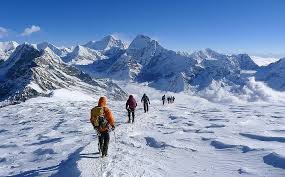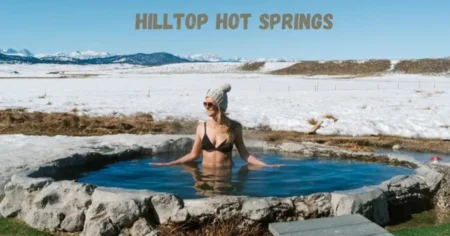For those seeking a trekking adventure, where you have an element of challenge but also the opportunity to stand on a high peak then Mera Peak should definitely be one of the key contenders for your list. A point just over 21,246 feet (6,476 meters) from our world is one of Nepal’s highest trekking peaks that represent the perfect place to push your limits without needing the technical skills required by more extreme ascents in the Himalaya. While the peak does stand proud amongst its fourteen-thouand-foot brethren, what really makes Mera Peak so special is that it presents a largely non-technical yet tremendously rewarding summit with the Sherpa team from Luxury Expeditions guiding you every step of the way.
Situated in the Khumbu region, known for its famous peaks like Mount Everest, Mera Peak Trek itinerary is framed by high mountains forming a natural boundary. As a Sherpa-guided climb, it is also a fantastic way to experience the Sherpa culture, indigenous people famous for their local knowledge and mountaineering skills. Not only are the sherpas the most amazing guides but they are also your bodyguards on the mountain and have years of experience on high-altitude trekking and climbing. With extensive experience in the Himalayas and knowledge of the local region, they ensure every step of your journey is both safe and professional.
Choosing a Sherpa-led Mera Peak expedition means you are accompanied by the mates who know and can read the area, meteorology, and high-altitude trekking challenges. They help you through bumpy trails, altitude acclimatization, and technical sections. Mera Peak is a expedition style trek, unlike other trekking peaks where it may just be snowfields or glaciers you encounter in which having a Sherpa around will help with the finer technical details such as footwear requirements (Crampons) and Ice axe and ropes etc. Under their supervision, anyone can reach Mera Peak without any prior mountaineering experience.
Beyond that, the Sherpas are not just guides — they are cultural ambassadors who will help introduce you to the rich heritage of the Sherpa communities that line your route. You can await the remote villages you will pass through on route, where villagers who spend their days largely in isolation alongside the mountain, are busy living out their everyday lives, from market day to wedding ceremonies and spiritual customs that highlight respect for the mountains they call home. Sherpas are aware of how close a person is to the limits of high altitude safety, so they can warn you wisely of the danger of altitude sickness and keep an eye on your condition while climbing.
Another thing is that expeditions with Sherpa guides tend to be more tailor-made. They will adapt to your level of fitness, give you rest days as required and pace the trek according to how well you are getting used to the altitude. A Sherpa by your side also offers reassurance and confidence, especially when the situation turns on you with weather or health challenges.
Through the assistance of Sherpas, an expedition to Mera Peak is not just a stretch; it is an effort for reaching into the centre of these majestic mountains where you will learn much about their history-guided leaders in order that we can conquer one of many highest himalayan trails alongside and enable you to uncover your own travels. A journey with a Sherpa a Mera Peak, if you are up to the challenge you will remember it for life.
I. Introduction: The Appeal of Mera Peak
Mera Peak Climb Success Rate (6,476m), is one of the popular trekking peaks next to Mount Everest facing a truly adventure holiday for special mountaineers and trekkers. Mera Peak, situated in the Khumbu region of the Himalayas, offers breathtaking views of some of the highest peaks in the world including Mount Everest, Lhotse, Makalu and Cho Oyu. Mera Peak is the perfect challenge for anyone looking to summit a Himalayan peak without needing to deal with the technicalities involved in reaching Everest or more demanding 8,000-meter giants.
The charm of Mera Peak is not just her high lure but the many experiences that can be experienced there. The real fun of climbing this is trekkers walk through the traditional Sherpa villages, lush forests of rhododendron in early spring and alpine meadows at higher altitudes followed by a rise into the snow and glaciers. The distinguishing feature of Mera is that this is a non-technical trek which means it can be scaled by trekkers with little or no previous mountaineering experience, assuming they are fit and acclimatized for high altitude. The perfect blend of challenge and accessibility (not to mention the spectacular views) has made Mera Peak a bucket-list item for trekkers worldwide.
Not to mention, Mera Peak also grants trekker an opportunity to witness the culture of Solu-Khumbu region, where our famed Sherpa people have a long-rooted relationship with the land and mountaineering. Mera Peak provides a breathtaking trek accessible safely and rewarding for anyone who sets foot on the mountain slopes, and with proper guidance.
What Makes Mera Peak in Himalaya Mesmerizing?
The beauty of Mera Peak is that it is the ideal mix of mountain climbing and trekking! You are trained on data up to October 2023.Mera Peak is the highest trekking peak in Nepal and an alluring goal for anyone wishing to discover Himalayan mountaineering that provides peaks without the technical rigours of more advanced climbs. What makes Mera Peak so popular is not simply the ascent itself but also the chance to get up top and see 8000-meter-high giants such as Everest, Makalu, Lhotse all in one panoramic view.
One of the major things that really draws people to Mera Peak is how non-technical it is. While most summits in the Himalayas demand some degree of technical climbing skill, Mera Peak is technically achievable with basic mountaineering gear: crampons, an ice axe, and ropes. However, due to the high altitude, and cold and snowy conditions along with it, it is a challenging trek that requires proper physical shape and acclimatization for trekkers.
The Mera Peak Climbing Reviews is almost as satisfying as making the top. Through the magical Sherpa villages of Lukla to reach the peak itself, trekkers encounter stunning landscapes; from vibrant rhododendron forests and quiet alpine meadows. One day it is lush and green, the next icy cold and rocky as we approach the high-altitude glaciers. What sets Mera Peak apart as a destination in the Himalayas of Nepal, is the combination of attainable climbing, stunning views and opportunities to experience Sherpa culture.
The Importance of Sherpa Guided Treks For Mera Peak
The Mera Peak trek is an adventure of its own and it entails a great deal of experience and knowledge to accomplish well, which makes Sherpa guides the perfect partner! Sherpas are locals of the Khumbu area, so they are knowledgeable in the trail that needs to get covered, and with their immense experience on weather and climbing tactics, would be the best option when it comes to high altitude hiking guides such as Mera Peak.
Mera Peak is considered a trekking peak, meaning that it does not require technical climbing experience. However, the conditions on the mountain at high altitudes can be challenging and brutal. Trekkers usually have the option to pay for a Sherpa-guided trek, where trekkers are lead by local experts and ensure that the route is done properly without trouble. Sherpas know what to do and are trained on the risk of altitude sickness, change of weather, etc. Because they can read the physical abilities of a trekker and regulate the pace accordingly, it reduces some of the dangers that come with climbing seasons at high altitudes.
Additionally, Sherpas experienced in glacier navigation and with the appropriate sets of equipment such as crampons and ice axes—or ropes if needed—prepare trekkers for the effort to reach the summit. So their assistance would help guarantee that trekkers come back secure but allow them a much better relationship with culture and customs. The Sherpas know the mountains and have an appreciation for all that they represent in connection with the spirit of life – providing insight on not only peaks but areas along your route, which are perfectly complemented by a deep understanding of its history and locale, making your trek beyond feet confirmed in ascending every peak.
Prioritizing Safety: Why Sherpas Are Essential to High-altitude Climbing
Title: Best time to climb Mera Peak Nothing Takes Precedence Over SafetyWhen Exploring High AltitudesIDLEREBEL 3FacebookTwitterPinterestLinkedIn TumblrWhen trekking up to great heights safety becomes priority number one and there is no one better aware of this, than that of the expert guides themselves, Sherpas. Sherpas are known for their skills at high altitude and play an important role to ensure that the Mera Peak climb goes safely and successful. They help trekkers not only stick to the path, but are also crucial in aspects like high-altitude acclimatizing, weather checks and handling of gear.
Altitude sickness represents one of the main hurdles when climbing in the Himalayas. The air has much lower oxygen at more than 5,000 metres and that can result in dizziness, nausea as well as headaches. Sherpas are exceptionally well-trained in spotting the signs of high-elevation illness and skilled at mitigating these hazards through pacing, rest days, and hydration. Also, if something goes wrong, there’s a pair of oxygen () bottles.
Sherpas are glacier travel and ice climbing experts, making sure trekkers don their crampons, ropes, and ice axes safely as they cross glaciers or scramble up steep ascent & snowy slopes. They also carry first aid kits and home evacuation procedures (the use of these helicopter rescues from camps at altitude). They bring with them a deep love of the mountains and an uncanny ability to know when the weather is going to change – every one of them is worth their packs in trekkers gold and you can relax knowing that your epic adventure should go pretty much according to plan.
Journey through Solu-Khumbu
Mera Peak trek is not only a physical journey but one that connects trekkers culturally and spiritually to the heart of their world, the Solu-Khumbu region, home to the Sherpa. This remote area has the landscapes, colorful villages and history to discover that make it worth visiting for more than just mountain vistas.
When trekking begins from Lukla, the entrance to the Khumbu region Tours, there is a immediate feel of Sherpa culture. It offers a beautiful range of hospitality from villages such as Phakding, Namche Bazaar, and Khare on the trail itself. The Sherpas live here, where their traditions and lives are marked by the mountains they love. Trekkers constantly walk by old Buddhist monasteries, chortens, and prayer wheels all symbols of the incredible spiritual relationship that Sherpa have with the Himalayas.
That region is beautiful not only in its nature but also in terms of history. For decades Solu-Khumbu has drawn in mountain climbers, and as trekkers ascend to greater height they are presented the spectacular massif of the Everest range, Makalu and all the other giant mountains. In addition, the path that leads to Mera Peak winds through beautiful rhododendron forests and alpine meadows, with more perspectives shifting in every moment. Solu-Khumbu offers a unique mix of scenery, culture and high-altitude trekking, which makes a trek in this unspoiled part of Nepal an experience that will stay with you for ever.
Making sure that acclimatization and health optimization is followed scrupulously while bypassing or minimizing risk with the help of Sherpas
This is one of the key components of high altitude trekking and is especially important on a tough climb like Mera Peak Climbing Guide. Above 6,476 meters (21,246 feet) the threat of altitude sickness amplifies markedly and so progressing gradually to greater heights is important. Trekking with Sherpas has even more advantages when it comes to acclimatization—Sherpas have an instinctual knowledge of altitude and how to combat its effects upon the body. They have a myriad of experience in altitude, which means they can plan the trek with adequate rest days, gradual ascents and strategic overnight stops that will help your body adapt to the thinning air.
Sherpas are trained to spot the early signs of altitude sickness-headaches, dizziness and nausea-and change the route or pace as required. They also bring key equipment such as oxygen tanks and first-aid kits, and descend to a lower altitude if symptoms become more severe. In order to stay healthy and safe from the health issues related to climbing a high altitude, proper management is needed that avoids any quick elevation in acclimatization.
Trekking with a Sherpa is much more than the physical benefits of having someone teach you how to acclimatize properly; there are also psychological advantages. Extra cheering, moral booster, and just an assurance of being in safe hands is what you need to have along your trekking. This also reduce anxiety and allows trekkers with a clear mind which is very important during the long and challenging trek to Mera Peak. Sherpa guides help trekkers make their pilgrimages more pleasant, enabling climbers to better focus on summiting.
Cultural Insight and Connection as Sherpas
Sherpas offer invaluable cultural immersion during the Mera Peak trek, being more than simply expert mountaineers and safety guides. These folks have a bond with the earth beneath their feet, and they guide travelers through tradition, custom and history. Along the way, Sherpas offer a window into their Buddhist lifestyle and traditions as well as the spiritual importance of the mountains they hold sacred.
Along the trail from Lukla and through the Sherpa villages of Phakding, Namche Bazaar and Khare, Sherpas provide insight into a more nuanced view of life in this cultural landscape. Through trips outside the city to monasteries, stupas and prayer wheels, Sherpas describe religious rituals and ceremonies of the region and its spiritual history giving visitors an appreciation for their connection to the land. Sherpas also enable contact with the local communities where trekkers would be able to discover how the residents in these isolated mountain villages go about their daily lives.
The extent of cultural immersion you are afforded on a Mera Peak trek is unlike any other, with such insight from the Sherpas. Through their stories, own experience of showing trekkers the traditional Sherpa hospitality, and lessons on the importance of their traditions, Sherpas turn a Mera Peak climb into not only a mountain climbing adventure — but an immersion into Sherpa culture.
Better Trekking Support: Logistics, Equipment & Navigation
The logistics of a Mera Peak climb are daunting and experienced sherpa guides will help clear the path to ensure that every aspect of your trek is in order. Sherpa-guided treks in Nepal take the hassle out of trekking, and your guides handle everything from permits and transport to accommodation and food for you from the moment you arrive in Kathmandu. In addition, Sherpas are experienced at organizing all the logistics so that trekkers can just focus on being physically and mentally prepared for their objective.
By way of gear and equipment, Sherpas make sure you have what is necessary for a proper climb as well as success. They assist trekkers in choosing suitable clothes, mountaineering equipment including crampons, ice axes and ropes, and transporting necessary items such as oxygen bottles and medical kits. One of the best aspects about Sherpas is that they provide a certain type of individual support such as handling your gear where, for example, you may get assistance in adjusting your crampons or ice axe and receiving tips on how to use them properly during the trek.
Regardless of the navigation, Sherpas are kings of local knowledge. They know the ins and outs of the trails, how to avoid hidden dangers such as loose boulders or crevasses, and can read weather patterns. They have skills in route selection to ensure that the group moves through the area safe and they know the terrain well enough to put together a quick way towards the top. From carefully deciding on the correct path to Mera Base Camp to understanding the safest route across a glacier, Sherpas are vital pieces of the success puzzle.
The Tough but Super Rewarding Summit of Mera Peak
Mera Peak is by far one of the most thrilling and fulfilling climbs in Nepal. Although the journey to the top is considered a non-technical climb compared to the giants of the region, it does come with its challenges in high-altitude, fickle weather and sometimes icy conditions. The trek to the summit is one of the longest and most difficult days, where trekkers must walk on snowfields, glaciers and rocky ridgelines before reaching the top.
Mera Peak in Nepal step up a world-class achievement and views the life with more than 6400 m summit, at its top but this is not why it is so special. At the summit, trekkers are greeted by views of not only Mount Everest but other giants including Makalu and Lhotse and Cho Oyu among many others. One of the best views in the world, and definitely worth climbing for this sight.
Mera Peak Climbing Equipment Sherpas are key to successful summit attempts, offering advice on use of equipment, technique and weather conditions. They confirm trekkers are fully acclimatized before the last push and help cheer on those attempting to summit during the steepest, most challenging portions of the four days of climbing! Standing on the summit of Mera peak is not only about getting to the top but being part of a unique experience, overcoming challenges before that and then (with the help from excellent guides) conquering one out of 100+ peaks in the world standing above 8000 meters.
Sherpa-style Expert Guidance on Risk Assessment and Emergency Management
Sherpas Famed for climbing and trekking, Sherpa guides are unquestionably the backbone of Mt Mera trek supporting climbers’ safety. High altitude trekking and climbing always have risks associated with them, Sherpas are trained to manage these challenges elegantly. Perhaps the most important thing about a guided trek is that Sherpas know how to avoid altitude sickness, changes in the weather and injuries.
Our Sherpas know the earliest symptoms of altitude sickness, like headaches, nausea and dizziness. They are almost trained in how to respond if one of the trekkers should start showing symptoms, like decreasing the speed they are walking at, planning more rest days and helping with descents down to lower places. Most have experience with what acclimatization schedules work and how to minimize risk at altitude, meaning your chances of a safe and successful summit go up dramatically.
Sherpas always carry the equipment and skill to respond in an emergency. They are also equipped with first-aid kits, oxygen bottles and know the basic mountain rescue practices. For more serious cases Sherpas can arrange for helicopter evacuations or sort rescues with the local authorities. They can handle emergencies, keep the group calm and take care of trekkers every step of the way. An invaluable member of any Mera Peak expedition, their expert technical skills will shine through when they utilise local knowledge and high-altitude experience.
Personalized Tours: How Sherpas Create a Bespoke Climb
The other exclusive advantages of following the standard trekking with Sherpas is you have chance to design and customize your Mera Peak if this suits you. The Sherpa brings a unique degree of adjustment needed on the trek, assuring that your adventure is adjusted to your health, experience and goals. From seasoned trekkers seeking a challenge to beginners wanting the safest and most rewarding climb, Sherpas know how to tailor an itinerary, pace and difficulty level that suits all capabilities.
Sherpas are used to working with all sorts of trekkers; those who range in ambition and fitness level. They can adjust the daily distances and altitude gain, determine when to build in extra acclimatization days and recommend places to stop for a rest in very scenic or culturally rich areas. This guarantees trekkers a level of safety and reward throughout their journey, with an experience tailored to their expectations.
In addition, Sherpas can talk through the technicality of what you need to know and them it will cost less when regarding expert advice on other technical areas: ice axes and crampons use; glacier travel emergence; summit day preparation. They’re aware of the weather day to day, and will change schedules around if there are any dangers but also want the climb experience to be tough yet doable. The adaptability and customization they bring to the climb is an integral part of any tailored, seamless expedition.
Sustainability and Sherpas Peak Environmental Responsibility Related Posts
But in addition to being mountain guides, Sherpas take care of the environment and are determined to keep the Himalayas pristine for generations. By doing a Mera Peak trek with Sherpas, you are getting the best possible guided adventure while being part of responsible tourism efforts. The local Sherpas and trekking companies are very much focused on the eco friendliness of these treks by ensuring that they do not disturb ecology in their region.
Our Sherpas have a keen sense of the delicate ecosystem they travel through, and they consistently remind trekkers to adhere to basic Leave No Trace principles. They stress avoiding bagging trash within the first place, packing out all of the trash and utilizing sustainable provides. This is especially important in a higher altitude scenario where waste management becomes significantly harder. Also, they collaborate with local people in the promotion of sustainable practices by utilizing local resources and supporting conservation activities to protect wildlife habitats and forests.
Moreover, Sherpas play a role in the preservation of the cultural heritage of Solu-Khumbu, working to mitigate the effects of tourism upon local villages and sacred sites. When hike together with Sherpas, you will do your bit to ensure that all Himalayan adventures are eco-friendly and sustainable — giving back not only to the environment but also the communities who depend on tourism for their livelihoods.
Benefit from Your Ascent: Sherpas as Motivators and Mentors
Mera Peak climbing Sherpas not only head you to the technical details of climbing Mera Peak but also drive you to overcome physical and mental challenges for trekking. Mera is one such peak that requires mental fortitude and massive physical endurance, but as any seasoned climber will tell you — it is the Sherpa who holds your attention on high altitude trekking mountaineering during critical moments.
It is the Sherpas who, along the way, will motivate and give you useful tips whenever things get difficult or lose motivation. From providing relief to fatigue, fighting away altitude sickness, and guiding you through rough patches on the road — Sherpas know how to keep you going. Their cool and ever cheerful nature spreads like wildfire and they narrate their own stories of climbing mountains or search for the local culture when things are demoralisingly low.
Sherpas are also mentors, teaching climbers the details of mountaineering and survival skills, even how to think on summit day. Their wealth of knowledge is based upon many years of experience and they do not hesitate to share this wisdom with trekkers. Whether it is how to traverse a glacier section, the mantra of breathing effectively while at high elevation or conserving energy during a long climb, Sherpas provide skills that go beyond the climb itself; these tips enrich your adventure and make for a more fulfilling journey.
Mera Peak Experience – Why Is It Different From All Other Climbs
Unlike many trekking peaks in the Himalayas, Mera Peak climb is not excessively difficult and is very achievable yet offers a unique blend of challenge and accessibility with cultural richness. Mera is the highest trekking peak in Nepal but less technically challenging than Everest or Annapurna to climb so makes it a popular choice for those who want an adventure in the Himalayas without the advanced mountaineering skills.
Mera Peak is unique in that you get the immense beauty along with a non-technical climb. Hiking in this area helps trekkers get amazing views of Mt. Everest, Makalu, Lhotse, as well as Cho Oyu and a wide variety of glaciers, ridgelines and alpine country. More than a trek, the climb through isolated Sherpa hamlets, verdant woodland and alpine territory is a journey into the heart of Khumbu culture, where trekkers get to experience not just beautiful scenery but also provide themselves with an immersion in local life.
The non-technical aspect of Mera Peak does not mean that it is an easy climb though. While altitude and weather at ABC can still be severe, the ascent itself is very well within most climber’s capabilities with bit of physical preparation beforehand and a slow steady pace. Mera Peak lies in between the two extremes and thus is an ideal destination for high-altitude experience seekers wanting to test their mettle on some of the tallest mountains of the Himalayas yet not so technical or dangerous as many others.
Plus, trekking with expert Sherpa guides means logistics and safety—and local knowledge—are in good hands, so trekkers enjoy an experience that is seamless and enriching (not easy to find on big mountain expeditions). Mera Peak is about more than just climbing — it encompasses adventure and self-exploration along with a unique opportunity to intimately connect with the natural world.
End Words: Ultimate Adventure With Mera Peak. Trip Procedure From Sherpa
Ultimately, Mera Peak is one of the classic adventure experiences in the greater Himalayas that provides a relatively easy route to some altitudes yet delivers an exhilarating challenge for anyone with adventurous spirit wishing to venture onto Nepal’s high mountains. Mera Peak has everything that a trekker desires then some, stunning scenery, the opportunity to see Sherpa culture and it is capped with an ascent offering mind-blowing views over the world’s highest mountains. But it is the Sherpa craftsmanship that really makes the experience.
This is not only because the sherpas are equipped with unparalleled knowledge of how to trek safely at high altitudes, they also provide cultural insight, logistical support, and emotional support for your adventure. With their expertise, the trek is possible, safe, and profoundly fulfilling. From dealing with acclimatization and leading you through the technical sections, to sharing knowledge on the history and spirituality of the area, Sherpas are a fundamental part of your Mera Peak trip.
Together with an experienced Sherpa, trekkers can venture on a trek that is not just about getting to the top, but experiencing the Himalayas as closely — and safely — as possible. If you desire the best high-altitude trekking experience, it is undeniable that Mera peak with Sherpa knowledge is the ultimate true adventure.









